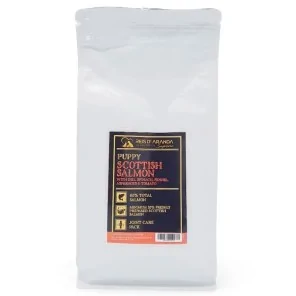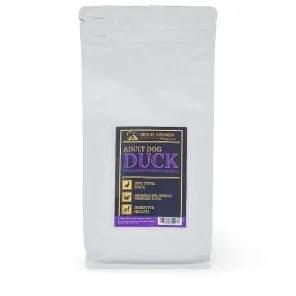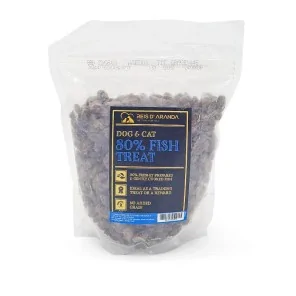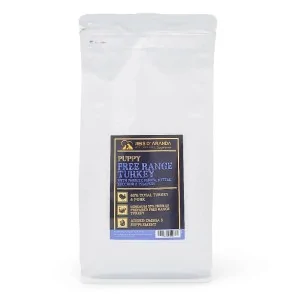Its name says it all: the Vienna blue rabbit comes from Austria. Not only is it beautiful with its shiny blue-grey...
THE SAARLOOS WOLFDOG
INTRODUCTION
The Saarloos wolfdog is a breed that originated in the Netherlands in the 1930s. It was created by Leendert Saarloos, a breeder who crossed European wolves with German Shepherds. The aim was to obtain a breed with the best characteristics of both. The result is a large-sized dog with an appearance reminiscent of its wild ancestor, the wolf.
THE ORIGIN OF THE SAARLOOS WOLF DOG
Leendert Saarloos (1884-1969) was a dog breeder of Dutch nationality, who believed that the German Shepherd was too sickly because its supposed origins were too close to the wolf and wanted to create a dog with the survival properties of the wolf in order to derive a working dog with a longer life span. In 1935, he crossed his German Shepherd Dog with a female Siberian Wolfhound, bred in Rotterdam Zoo.
The third litter (1938) produced a long-lived offspring which, when mixed with German Shepherds, resulted in a dog with a fourth recessive wolf blood. The result was a dog that was not useful as a working dog because of his stubborn temperament, but was a good companion for living close to nature and country areas. The Dutch Kennel Club recognised the breed in 1975. To honour its creator, they named the breed Saarloos Wolfdog. In 1981, the breed was recognised by the Fédération Cynologique Internationale (FCI).
In 2015, a study found that the Saarloos Wolfdog shows greater genetic association with the grey wolf than any other wolf breed, a result that is in keeping with the breed's documented crossbreeding with grey wolves. In 2016, a DNA study conducted on domestic dogs found a deep divide between the Saarloos wolf dog and other dog breeds probably produced by other dog breeders, highlighting a comparative decline of crossbreeding of German shepherds with captive wolves in the 1930s, followed later by crossbreeding with other dogs of Eurosian (eastern and western) origins.
The Dutch Kennel Club in a study investigated the possibilities of improving the health of this breed through greater genetic diversity. The first meetings with the Dutch Kennel Club were held in 2010. Following these meetings, Wageningen University and Research set out to investigate the degree of genetic interrelationship in the population. The search was conducted by geneticists J.J. Windig and M. Spies-Stoop. This study revealed that the population of Saarloos dogs was closely related to each other. Without intervention, this degree of inbreeding could affect their survival. The scientists advised to set up controlled and extensive breeding programmes to increase their vitality, fertility and genetic variation. The Dutch Kennel Club approved the programme in 2012.
Two types of crossbreeding are being used in the programme. The first type is the use of the so-called aesthetic look-alike, a breed of dog that resembles the Saarloos, but because it does not have a pedigree and does not belong to a defined breed it is not recognised by the FCI and has no official status.6 The second type is the use of several breeds recognised by the FCI. The breeds that are used are chosen by specialised members of the FCI and the candidates have to go through a ballot to be chosen by a majority vote. The procedure for both types of crossbreeding is the same. Selective breeding is administered and when the 1st generation (F1) is produced the resulting dogs are screened and the best are chosen to contribute to the next generation, whereby they are crossed with a Saarloos pedigree dog, which produces the 2nd generation (F2), which are themselves screened and health tested. The best of this generation will be re-crossed with purebred Saarloos to produce the 3rd generation (F3), which will be re-crossed with other purebred Saarloos. This 4th generation (F4) will get an official pedigree and will be recognised as purebred. All these crosses are intended to put an end to the inbreeding problems of the Saarloos.
In January 2019, the crossbreeding programme with other breeds had been planned as follows:
- White Swiss Shepherd (completing the F2 stage).
- Siberian Husky (completing stage F1)
- Podenco ibicenco (completing stage F1)
- Norwegian moose hunter (completing stage F1)
- Northern Inuit dog (completing stage F1)
WHAT IS THE SAARLOOS WOLF DOG LIKE?
GENERAL APPEARANCE: The Saarloos Wolfhound is a strongly built dog, whose external appearance (structure, movement and coat) is reminiscent of the wolf. His build is balanced and he has fairly long limbs without giving the appearance of being long-limbed. Differences in secondary sexual characteristics are pronounced between males and females.
IMPORTANT PROPORTIONS: The Saarloos Wolfdog is longer than its height at withers. The ratio of length of muzzle to length of skull is 1:1.
HEAD: Should give the appearance of a wolf and its size should be harmonious in relation to the body. Seen from above and from the side, it is wedge-shaped. The line of the muzzle towards the well developed zygomatic arch is very characteristic. Together with the correct position and shape of the eyes, this line gives the desired wolf-like appearance.
CRANIAL REGION:
SKULL: Broad and flattened. Exaggeration with regard to width should be avoided as this affects its typical wedge shape. Occiput and eye socket should not be noticeable. The superciliary arches join in a flowing line with the skull.
STOP: The transition from the strong muzzle to the skull should form a slight stop.
FACIAL REGION:
TRUFA: Well pigmented. The muzzle is straight.
EAR: Seen from the side, not too deep and slightly wedge-shaped. Seen from above it tapers slightly and is harmoniously full under the eyes. Too thick a muzzle disfigures the typical wolf shape.
LIPS: Well closed. Tight.
JAWS / TEETH: Upper and lower jaws well developed. The upper jaw should not appear grotesque in comparison with the skull. The lower jaw is not noticeable.
Strong and complete scissor bite is also acceptable in the form of a tight scissor bite.
EYES: Yellow, almond shaped. Set slightly oblique, neither protruding nor round, with tightly fitting eyelids.
The expression is alert, reserved, but not anxious. The eyes are a typical breed characteristic which emphasises the desired wolf-like appearance. The desired expression is only achieved with clear eyes. Great value should be placed on colour, shape and correct position in the skull.
In older dogs the yellow colour may darken but the original disposition to a yellow colour should be maintained. Brown eyes are undesirable. The eye sockets merge into the skull in a flowing line. Very pronounced orbits coupled with a pronounced superciliary arch and a marked stop are undesirable.
EAR: Medium size, firmly erect, triangular, with rounded tip. With hair on the inside. Set on at eye level. They are highly mobile and express the dog's emotions and feelings.
NECK: Dry and very muscular, joining the back in a flowing line. Just as flowing is the line joining the throat to the chest. The neck may, especially with winter coat, be adorned with a beautiful ruff. The throat fur is minimal and not noticeable. It is typical for the Saarloos Wolfdog that, in a relaxed trot, the head and neck almost form a horizontal line.
BODY
BACK: Straight and strong.
LOIN: Firm, well muscled, neither short nor narrow.
Croup: Broad and fairly long.
CHEST: The slack line of the sternum reaches at most to the elbows.
Chest and distance between forelegs, seen from the front, appear moderately broad. A very massive chest should be avoided as it distorts the silhouette which typifies this hardy trotter. Ribs well sprung but without exaggeration. The silhouette is preferably lean and extremely wolf-like.
BOTTOM LINE AND BELLY: Taut and slightly tucked up.
TAIL: Broad and profusely set on, reaching at least to the hocks. Seen slightly low set, which is generally accentuated by a slight depression in the set on. The tail is carried slightly curved in sabre shape or almost straight. It may be carried slightly higher when the dog is excited or trotting.
LIMBS
FOREQUARTERS:
GENERAL APPEARANCE: Straight and well muscled. The bones are oval in cross section and not very thick.
Generally, the forelegs show a certain gracefulness in relation to the body.
SCAPULA: Of normal length.
ARM: Of the same length as the shoulder-blade; the angulation between the shoulder-blade and the upper arm is normal, not exaggerated.
ELBOWS: Close to the chest without being tight. Due to the curve of the ribs and the correct position of the shoulders and upper arm, the distance between the forelegs is moderately wide when viewed from the front.
FOREARMS: Straight and parallel, of strong bone and sufficient density and length.
CHEEKS: With strong carpal joints.
METACARPERS: Slightly sloping.
HANDS: Hare feet, well muscled and arched with strongly developed pads. When the dog is standing, a slightly outward position of the feet is permissible.
HINDQUARTERS:
GENERAL APPEARANCE: Due to the low set on tail, which is generally accentuated by a slight depression, the pelvis often appears to be set more obliquely. The angulation of the hindquarters is in balance with the angulation of the forelegs. The slight movement, typical of the breed, is dependent on the correct angulation of the knee and hock. The slightest deviation prevents this typical movement. Light cow hocks are permitted when standing.
THIGH: Normal length and width, strongly muscled.
KNEE: Angulation not exaggerated.
HINDQUARTERS: Approximately the same length as the femur and well muscled.
Hock: Angulation should not be exaggerated. Bones and muscles allow optimum narrowing of the hock joint.
METATARSUS: Of medium length and slightly sloping when the dog is standing.
FEET: Well developed and well arched.
GAIT / MOVEMENT: The Saarloos Wolfhound is a typical tireless trotter, which can easily cover long distances at its own pace. He tires very little due to his natural movement reminiscent of the wolf. The Saarloos Wolfdog differs greatly from other breeds by its very specific, agile and light movement. Correct forward movement is very dependent on different details in the construction of the body; but, above all, the correct angulations of the limbs are of great influence.
The strong carpal joints and the slight inclination of the metacarpals are responsible for the good elastic, supple and effortless movement. In a free and easy trot the Saarloos Wolfdog carries his neck and head almost horizontally: in this position the position of the eyes and the wedge shape of the head are particularly characteristic. In a tireless trot, which is the typical movement of the breed, the dog shows little reach, because this, as well as too much drive, can spoil the light, agile movement, which is an energy-saving movement pattern.
COAT
COAT: The summer coat differs greatly from the winter coat. In winter the undercoat (undercoat) generally predominates, which together with the hair of the outer coat forms an abundant coat, covering the whole body and forming a distinctive collar on the neck. In the summer coat, the hair of the outer coat predominates. The change of temperature in autumn and winter can have a great influence on the undercoat, but readiness for this must always be present. It is essential that the belly, inner thighs and scrotum are covered with hair.
COLOUR: The coat colours range from light to dark shades, with black coat tip, prey colour (boar, hare) also called wolf grey and from light to dark shades with brown coat tip also prey colour. The typical wolf markings range from light cream to whitish-white. These pale markings, typical of wolves, extend to the underside of the body, the inner side of the limbs, the back of the paws, the breeches and under the tail.
The pigmentation of the nose, eyelids, lips and nails should be black in wolf-grey, white and creamy white Saarloos. In brown Saarloos they should be liver coloured.
Both colour varieties show a darker shade of colour on the outside of the limbs. They should also have an expressive mask.
SIZE:
HEIGHT AT WITHERS:
- Males: 65 to 75 cm.
- Bitches: 60 to 70 cm.
Slight deviations upwards are permissible.
FAULTS: Any departure from the foregoing points should be considered a fault and the seriousness with which the fault should be regarded should be in exact proportion to its degree and its effect upon the health and welfare of the dog.
- Eyes too round or protruding.
- Too pronounced eye sockets which do not allow the superciliary bridges to merge smoothly with the skull. This usually occurs when the stop is too pronounced and the eyes too round.
- Ears set too high and/or pointed ears.
- Ears pointing too far outwards.
- Body too deep, too short.
- Tail curled, tail carried over the back.
- Bone too heavy.
- Colour not sufficiently intense.
- Formation of a black coat due to poor distribution of dark hair.
DISQUALIFYING FAULTS:
- Aggressiveness or extreme shyness.
- Any dog showing clear signs of physical or behavioural abnormalities.
- Breed type fault.
- Any colour other than those permitted.
N.B.:
- Male dogs should have two apparently normal appearing testicles fully descended into the scrotum.
- Only functionally and clinically healthy dogs of typical breed conformation should be used for breeding.
PERSONALITY: Although their appearance may appear intimidating, they are known for their gentle and loyal nature. They are intelligent and courageous, but are also sensitive and require early socialisation and proper training (preferably by a professional). Being descended from wolves, they still retain some behavioural traits of their wild ancestors. They are independent and have a strong need to explore and venture into their environment. However, they are also very loyal to their owners and can form strong bonds with them. Keep in mind that this is not a breed suitable for all dog mums and dads. They require humans who can set clear boundaries and provide them with proper training from an early age. It is ideal for people who are strong-willed, solitary and have enough space in their homes.
DIFFERENCES BETWEEN THE SAARLOOS WOLFDOG AND THE CZECHOSLOVAKIAN WOLFDOG
In general appearance, the PLC gives the impression of a lighter bone structure than the PLS, especially the Slovakian line. Being a relatively young breed, it is therefore still evolving.
In terms of the head, both breeds have lupoid airs, with a liveliness of expression in the PLC while the PLS has a more reserved expression. The ears of the PLC are short, triangular and thin... Those of the PLS are medium sized, fleshy, triangular with a rounded end. Both PLC and PLS ears are set at eye level and hairy on the inside.
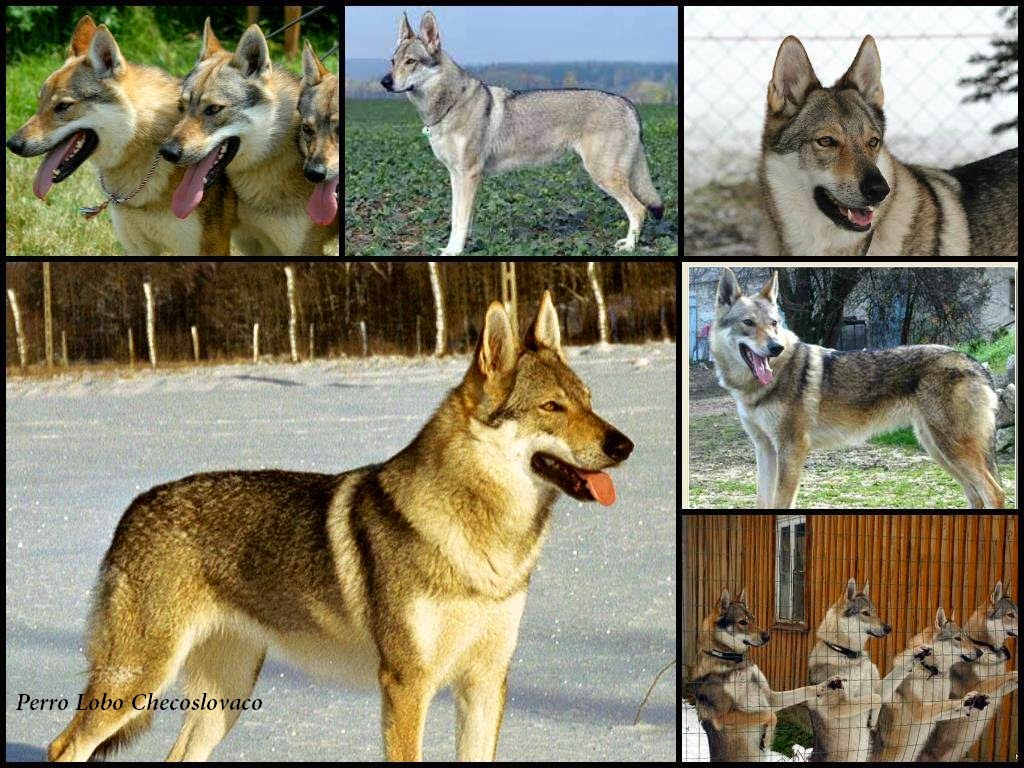
(Above: Czechoslovakian Wolf Dog)
Seen from the front of the PLC, the paws... Straight, stable and tight with feet slightly turned out. The PLC should have a moderately large chest. Feet slightly turned out are permissible.
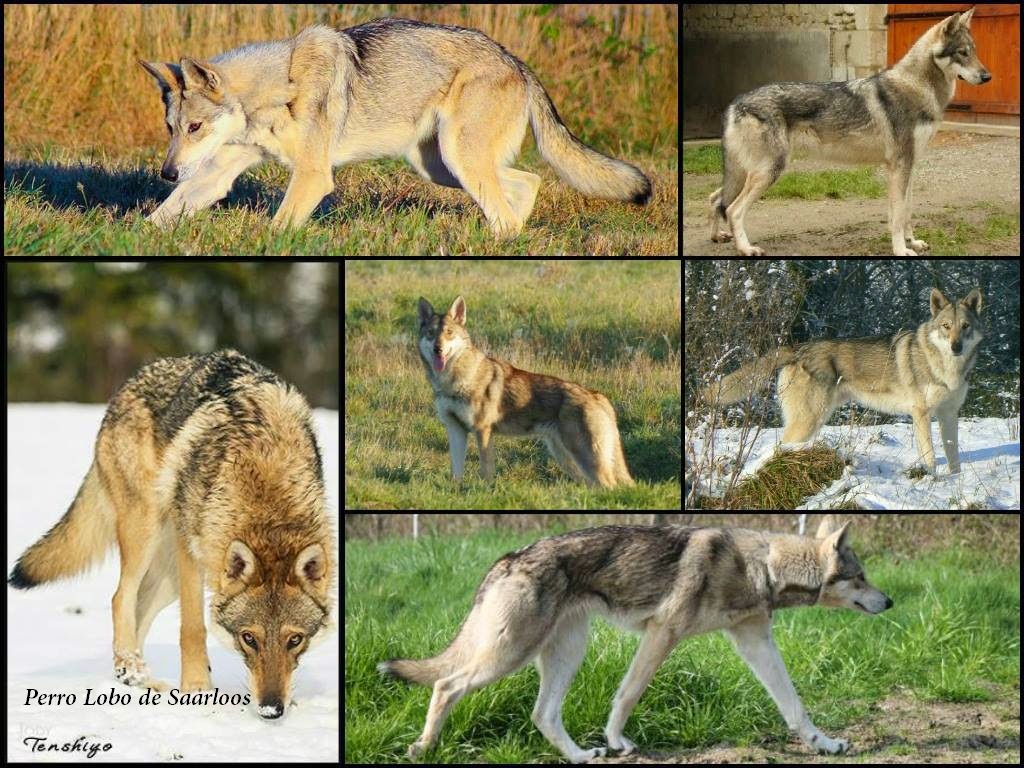
(Above: Saarloos Wolfdog).
Viewed from the side, we see that the chest of the PLS may descend to the elbow, whereas for the PLC it does not descend to the elbows. The point of the sternum cannot exceed the level of the shoulder joints. The line of the PLS is more linear while the PLC has a more pronounced withers and slightly more forward shoulders. Both have a straight back, but differ in the tail.
The PLC has a high set tail, hanging straight. During arousal, as a rule, the tail is raised in a sickle shape. The lumbar region is not broad, short, strong, well muscled and slightly sloping.
The PLS has a broad, profusely set on tail, reaching at least to the hocks. Set on slightly low, which is generally accentuated by a slight depression at the set on. The tail is carried slightly curved in sabre shape or almost straight. It may be carried slightly higher when the dog is excited or trotting. The position of the pelvis is normal. However, due to the low set tail, the pelvic socket appears more oblique.
The coat colours of the PLS are wolf-grey, forest brown and creamy white. While the PLC is yellow-grey to silver-grey and dark grey. But what is common is the presence of a mask which emphasises the expression. Another thing in common is the ability of these dogs to produce an abundant undercoat during the winter.
When choosing a dog you also have to take into account the activities you can do with the dog outside the home. The PLS has no great need for any sporting activity. However, to please his master he will do them. Although their physical abilities are identical, the PLC and the PLS have a very different mentality.
The PLC is more capable of obedience and general work. It is important to know that he needs a lot of physical activity.
Unlike the Czechoslovakian Wolfdog, the Saarloos tends to be more shy and less likely to show dominant behaviour. Their protective instinct is present but not dominant, making them discreet guardians. In addition, they have moderate to high energy and require both physical exercise and daily mental stimulation to avoid destructive behaviour.
THE HEALTH OF THE SAARLOOS WOLFDOG
Among the diseases and health conditions seen in this breed are muscle, joint and bone problems, due to their physical conformation, however, these are ailments that are seen in other dogs, such as hip dysplasia.
They are dogs that require a lot of exercise and physical activity to keep them happy and healthy, as they are an active and energetic breed, and it is advisable to provide them with enough time for long walks, running and playing outdoors. However, remember to do these exercises outdoors in a safe area or keep them on a leash at all times, due to their natural hunting instinct and desire to venture out on long walks.
They require early training and excellent socialisation, due to their independent nature and natural wolf instinct. This will help to develop their social skills, guard against aggressive attitudes and destruction of objects.
It is also recommended to expose them to different situations, visits to different places with crowds of people and other animals, helping them to adapt, feel safe and emotionally healthy; if we do it well and let ourselves be guided by professionals we will have an excellent companion for the next 10-12 years.
CONCLUSION
If you meet this challenge, you will have a trusted companion and a loyal family member by your side. In addition, the Saarloos wolfdog can be open and responsive to children, other pets and visitors. In fact, there is something else that characterises him: his remarkable loyalty and attachment to his chief wolf, his handler. However, do not expect blind obedience from him. This dog has a proud and independent character, so he always wonders what is the meaning of commands. Therefore, he will not lend himself to monotonous exercises and constant repetition of the same games. So you must use your imagination to satisfy and keep this demanding and energetic dog busy.
Leave a comment
Log in to post comments

